Abstract
It has been proposed that in children with severe head injuries the cerebral circulation does not respond appropriately to normal physiological control mechanisms, making children more susceptible than adults to low cerebrovascular resistance, increased cerebral blood flow (cerebral hyperaemia), and raised intracranial pressure. To investigate this issue, 122 serial measurements of cerebrovascular resistance in 17 children with severe head injuries have been performed and related to cerebral perfusion pressure, arterial CO2 (PaCO2), arterial oxygen content (AO2), and the cerebral metabolic rate of oxygen (CMRO2). Cerebrovascular resistance values (mean (SD) 1.54 (0.61) mm Hg.ml-1.100 g.min) were normal or raised in most cases; 71 values (58%) were within the normal range, 39 (32%) above the upper limit, and only 12 (10%) below the lower limit. There was a significant correlation between cerebral perfusion pressure and cerebrovascular resistance (r = 0.32, p = 0.0003), suggesting preservation of pressure autoregulation. This correlation was absent in four of the five children who died or survived with severe handicap. Analysis by multilevel modelling indicated that, as in normal subjects, CMRO2, CPP, AO2, PaCO2, and cerebrovenous pH were important independent determinants of cerebrovascular resistance. The results indicate that normal cerebrovascular reactivity is often preserved in children with severe head injuries but may be impaired in the most severely injured patients.
Full text
PDF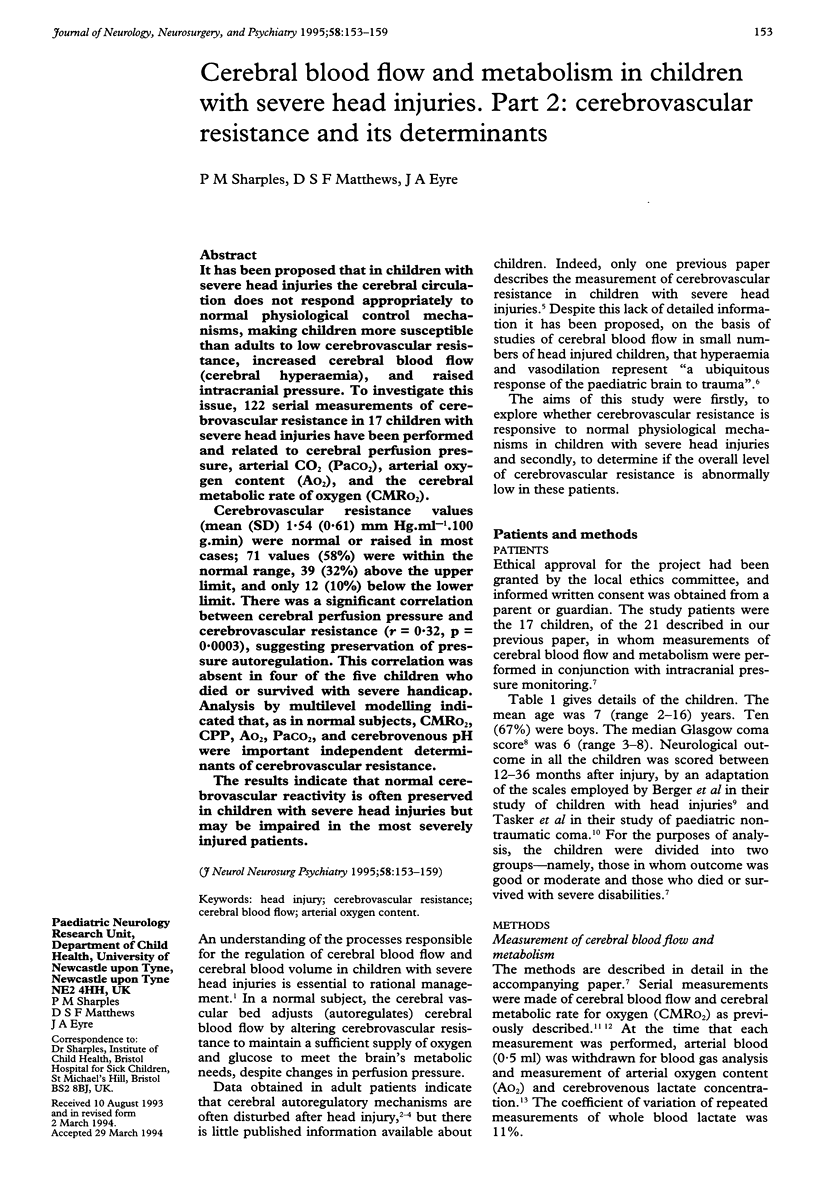
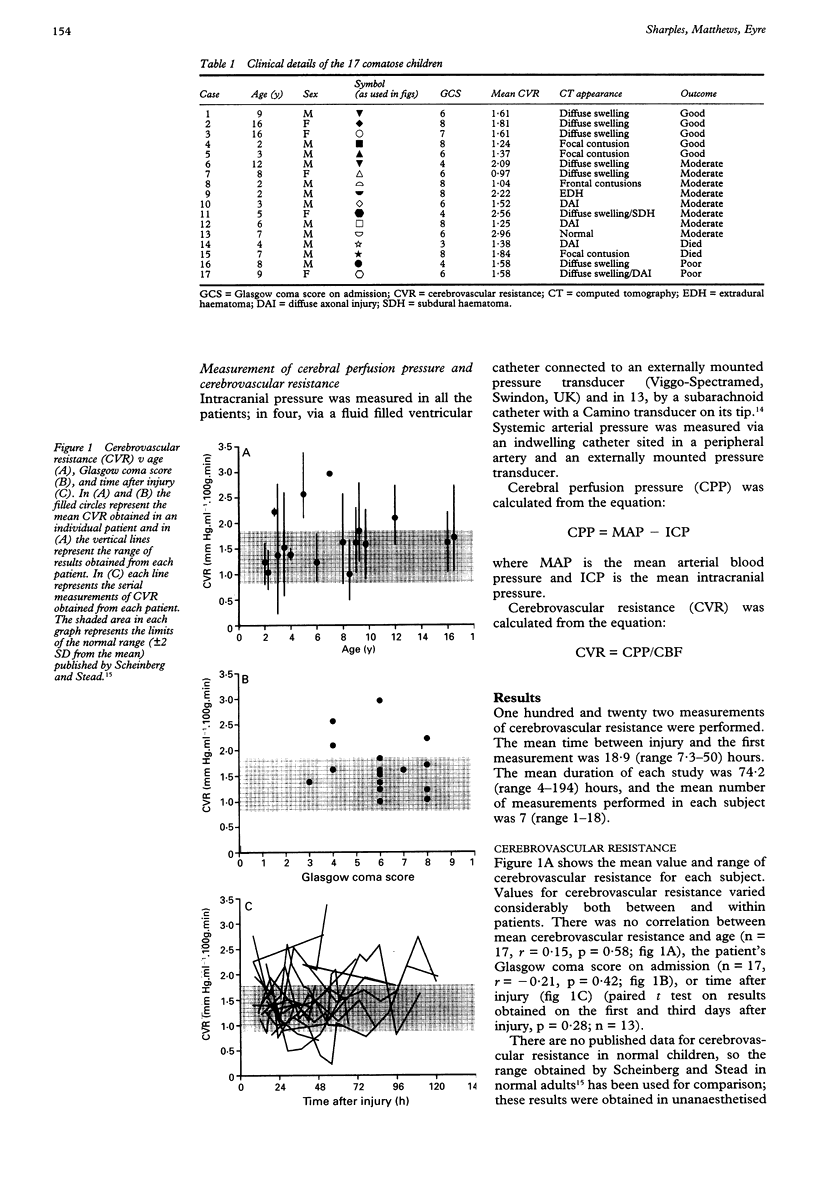
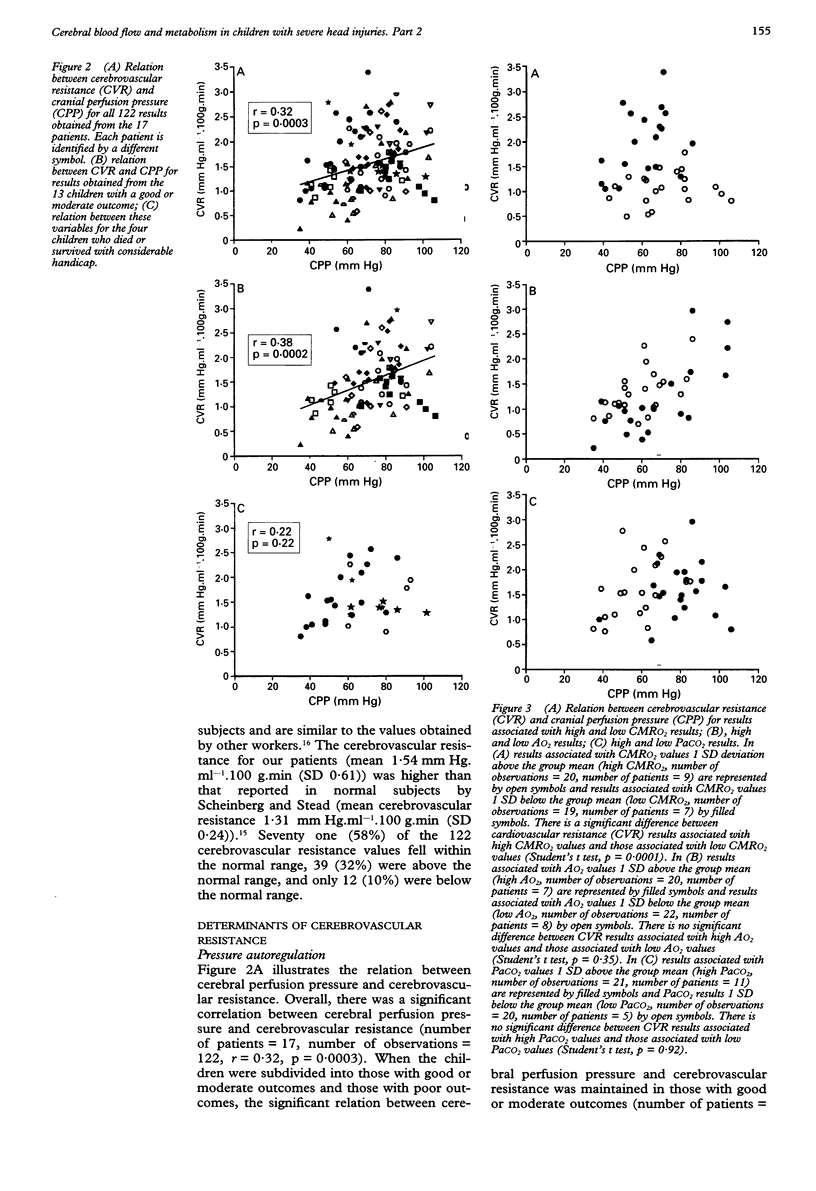
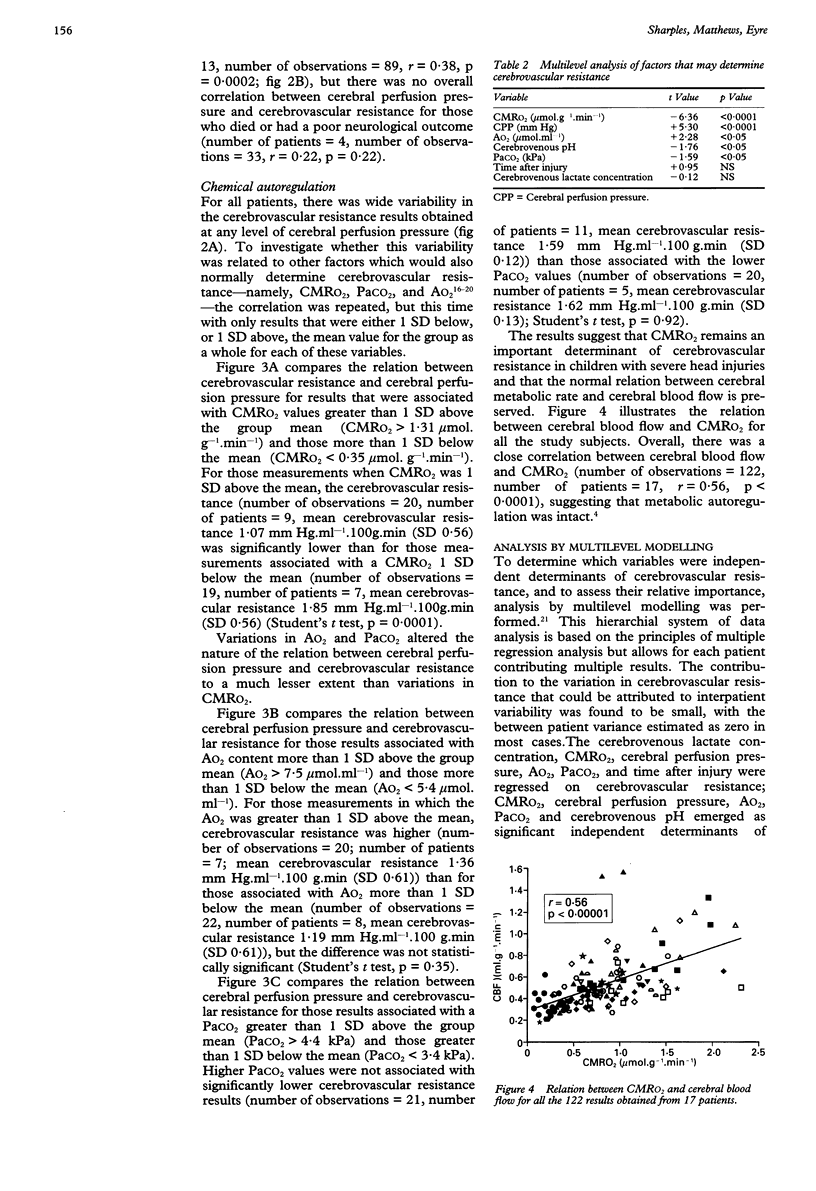
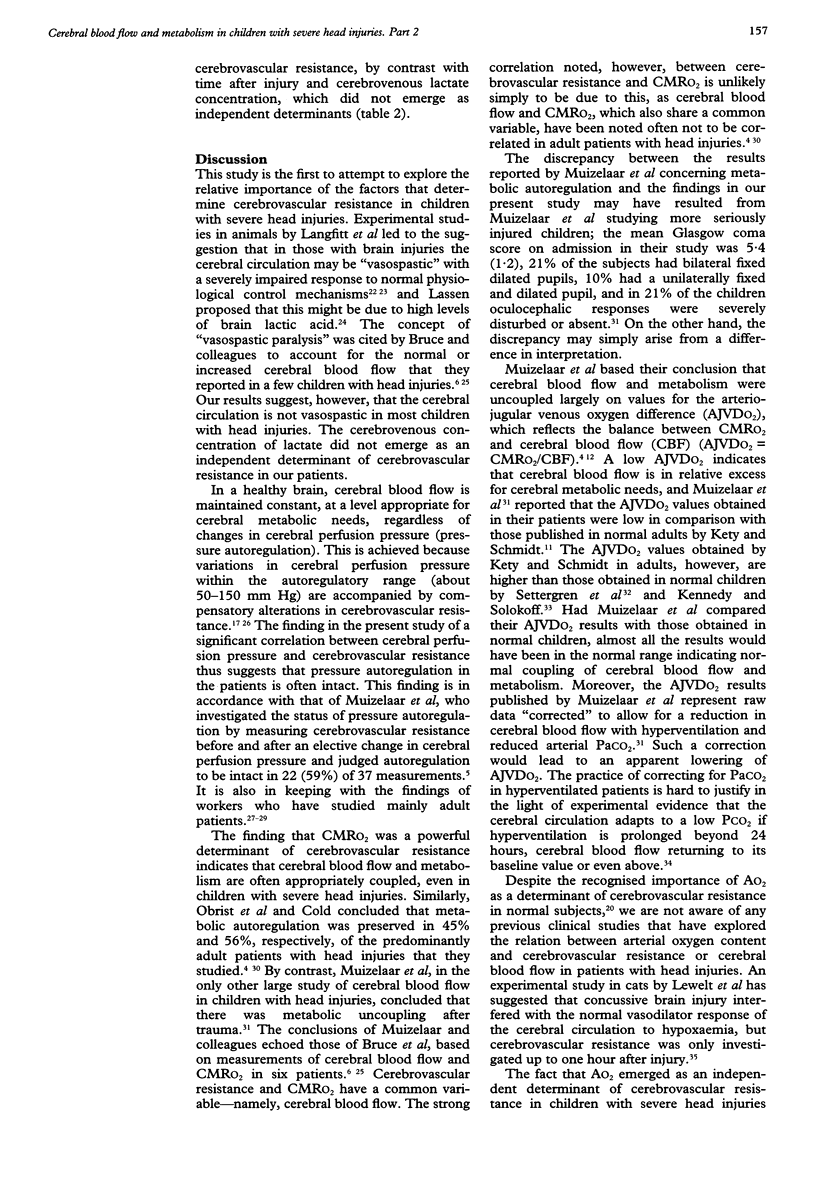
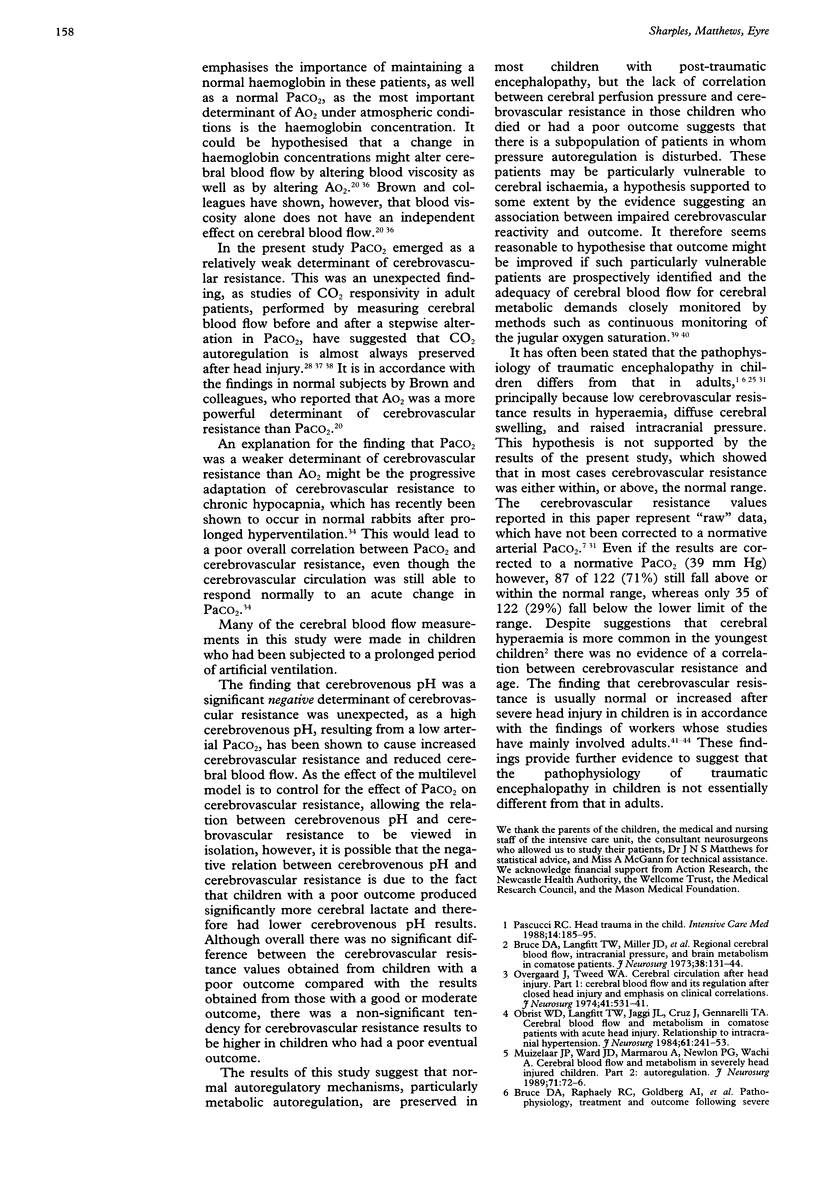
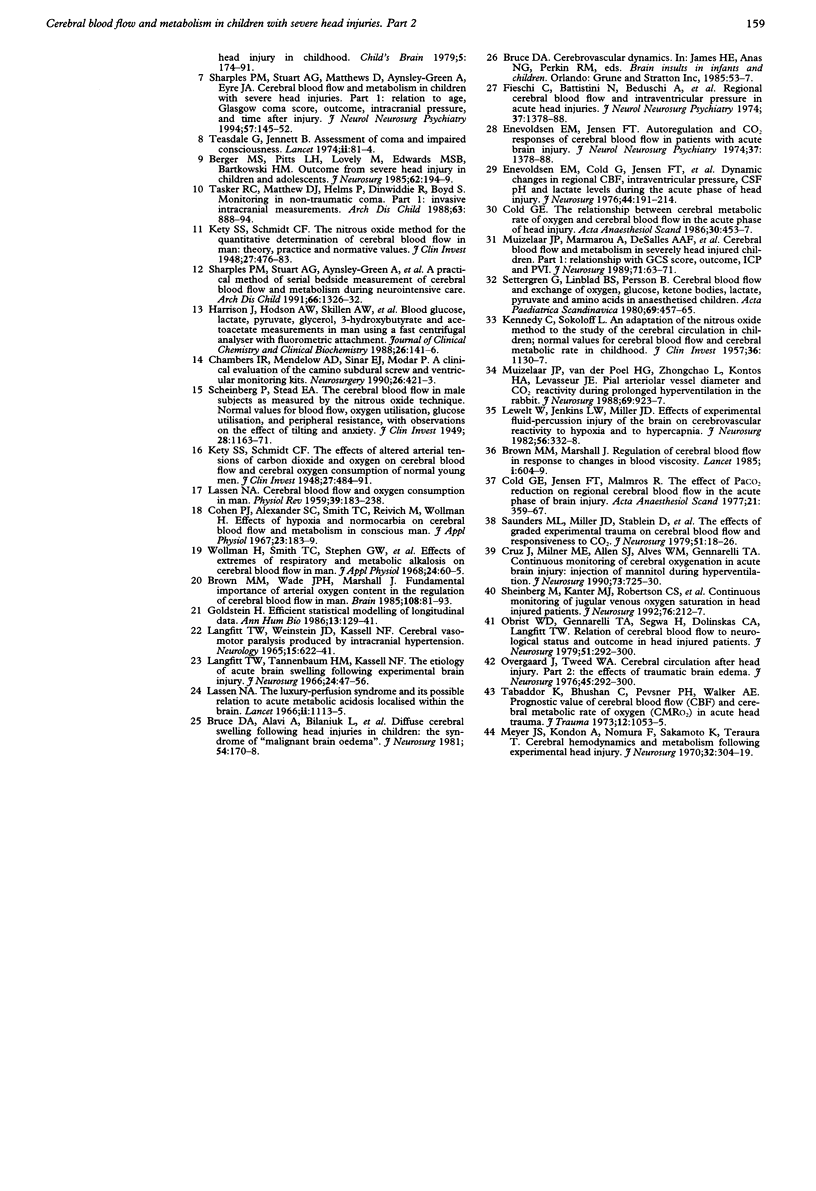
Selected References
These references are in PubMed. This may not be the complete list of references from this article.
- Berger M. S., Pitts L. H., Lovely M., Edwards M. S., Bartkowski H. M. Outcome from severe head injury in children and adolescents. J Neurosurg. 1985 Feb;62(2):194–199. doi: 10.3171/jns.1985.62.2.0194. [DOI] [PubMed] [Google Scholar]
- Brown M. M., Marshall J. Regulation of cerebral blood flow in response to changes in blood viscosity. Lancet. 1985 Mar 16;1(8429):604–609. doi: 10.1016/s0140-6736(85)92145-2. [DOI] [PubMed] [Google Scholar]
- Brown M. M., Wade J. P., Marshall J. Fundamental importance of arterial oxygen content in the regulation of cerebral blood flow in man. Brain. 1985 Mar;108(Pt 1):81–93. doi: 10.1093/brain/108.1.81. [DOI] [PubMed] [Google Scholar]
- Bruce D. A., Alavi A., Bilaniuk L., Dolinskas C., Obrist W., Uzzell B. Diffuse cerebral swelling following head injuries in children: the syndrome of "malignant brain edema". J Neurosurg. 1981 Feb;54(2):170–178. doi: 10.3171/jns.1981.54.2.0170. [DOI] [PubMed] [Google Scholar]
- Bruce D. A., Langfitt T. W., Miller J. D., Schutz H., Vapalahti M. P., Stanek A., Goldberg H. I. Regional cerebral blood flow, intracranial pressure, and brain metabolism in comatose patients. J Neurosurg. 1973 Feb;38(2):131–144. doi: 10.3171/jns.1973.38.2.0131. [DOI] [PubMed] [Google Scholar]
- Chambers I. R., Mendelow A. D., Sinar E. J., Modha P. A clinical evaluation of the Camino subdural screw and ventricular monitoring kits. Neurosurgery. 1990 Mar;26(3):421–423. doi: 10.1097/00006123-199003000-00007. [DOI] [PubMed] [Google Scholar]
- Cohen P. J., Alexander S. C., Smith T. C., Reivich M., Wollman H. Effects of hypoxia and normocarbia on cerebral blood flow and metabolism in conscious man. J Appl Physiol. 1967 Aug;23(2):183–189. doi: 10.1152/jappl.1967.23.2.183. [DOI] [PubMed] [Google Scholar]
- Cold G. E., Jensen F. T., Malmros R. The effects of PaCO2 reduction on regional cerebral blood flow in the acute phase of brain injury. Acta Anaesthesiol Scand. 1977;21(5):359–367. doi: 10.1111/j.1399-6576.1977.tb01232.x. [DOI] [PubMed] [Google Scholar]
- Cold G. E. The relationship between cerebral metabolic rate of oxygen and cerebral blood flow in the acute phase of head injury. Acta Anaesthesiol Scand. 1986 Aug;30(6):453–457. doi: 10.1111/j.1399-6576.1986.tb02452.x. [DOI] [PubMed] [Google Scholar]
- Cruz J., Miner M. E., Allen S. J., Alves W. M., Gennarelli T. A. Continuous monitoring of cerebral oxygenation in acute brain injury: injection of mannitol during hyperventilation. J Neurosurg. 1990 Nov;73(5):725–730. doi: 10.3171/jns.1990.73.5.0725. [DOI] [PubMed] [Google Scholar]
- Enevoldsen E. M., Cold G., Jensen F. T., Malmros R. Dynamic changes in regional CBF, intraventricular pressure, CSF pH and lactate levels during the acute phase of head injury. J Neurosurg. 1976 Feb;44(2):191–214. doi: 10.3171/jns.1976.44.2.0191. [DOI] [PubMed] [Google Scholar]
- Fieschi C., Battistini N., Beduschi A., Boselli L., Rossanda M. Regional cerebral blood flow and intraventricular pressure in acute head injuries. J Neurol Neurosurg Psychiatry. 1974 Dec;37(12):1378–1388. doi: 10.1136/jnnp.37.12.1378. [DOI] [PMC free article] [PubMed] [Google Scholar]
- Goldstein H. Efficient statistical modelling of longitudinal data. Ann Hum Biol. 1986 Mar-Apr;13(2):129–141. doi: 10.1080/03014468600008271. [DOI] [PubMed] [Google Scholar]
- Harrison J., Hodson A. W., Skillen A. W., Stappenbeck R., Agius L., Alberti K. G. Blood glucose, lactate, pyruvate, glycerol, 3-hydroxybutyrate and acetoacetate measurements in man using a centrifugal analyser with a fluorimetric attachment. J Clin Chem Clin Biochem. 1988 Mar;26(3):141–146. doi: 10.1515/cclm.1988.26.3.141. [DOI] [PubMed] [Google Scholar]
- KENNEDY C., SOKOLOFF L. An adaptation of the nitrous oxide method to the study of the cerebral circulation in children; normal values for cerebral blood flow and cerebral metabolic rate in childhood. J Clin Invest. 1957 Jul;36(7):1130–1137. doi: 10.1172/JCI103509. [DOI] [PMC free article] [PubMed] [Google Scholar]
- Kety S. S., Schmidt C. F. THE EFFECTS OF ALTERED ARTERIAL TENSIONS OF CARBON DIOXIDE AND OXYGEN ON CEREBRAL BLOOD FLOW AND CEREBRAL OXYGEN CONSUMPTION OF NORMAL YOUNG MEN. J Clin Invest. 1948 Jul;27(4):484–492. doi: 10.1172/JCI101995. [DOI] [PMC free article] [PubMed] [Google Scholar]
- Kety S. S., Schmidt C. F. THE NITROUS OXIDE METHOD FOR THE QUANTITATIVE DETERMINATION OF CEREBRAL BLOOD FLOW IN MAN: THEORY, PROCEDURE AND NORMAL VALUES. J Clin Invest. 1948 Jul;27(4):476–483. doi: 10.1172/JCI101994. [DOI] [PMC free article] [PubMed] [Google Scholar]
- LANGFITT T. W., WEINSTEIN J. D., KASSELL N. F. CEREBRAL VASOMOTOR PARALYSIS PRODUCED BY INTRACRANIAL HYPERTENSION. Neurology. 1965 Jul;15:622–641. doi: 10.1212/wnl.15.7.622. [DOI] [PubMed] [Google Scholar]
- LASSEN N. A. Cerebral blood flow and oxygen consumption in man. Physiol Rev. 1959 Apr;39(2):183–238. doi: 10.1152/physrev.1959.39.2.183. [DOI] [PubMed] [Google Scholar]
- Langfitt T. W., Tannanbaum H. M., Kassell N. F. The etiology of acute brain swelling following experimental head injury. J Neurosurg. 1966 Jan;24(1):47–56. doi: 10.3171/jns.1966.24.1.0047. [DOI] [PubMed] [Google Scholar]
- Lassen N. A. The luxury-perfusion syndrome and its possible relation to acute metabolic acidosis localised within the brain. Lancet. 1966 Nov 19;2(7473):1113–1115. doi: 10.1016/s0140-6736(66)92199-4. [DOI] [PubMed] [Google Scholar]
- Lewelt W., Jenkins L. W., Miller J. D. Effects of experimental fluid-percussion injury of the brain on cerebrovascular reactivity of hypoxia and to hypercapnia. J Neurosurg. 1982 Mar;56(3):332–338. doi: 10.3171/jns.1982.56.3.0332. [DOI] [PubMed] [Google Scholar]
- Meyer J. S., Kondo A., Nomura F., Sakamoto K., Teraura T. Cerebral hemodynamics and metabolism following experimental head injury. J Neurosurg. 1970 Mar;32(3):304–319. doi: 10.3171/jns.1970.32.3.0304. [DOI] [PubMed] [Google Scholar]
- Muizelaar J. P., Marmarou A., DeSalles A. A., Ward J. D., Zimmerman R. S., Li Z., Choi S. C., Young H. F. Cerebral blood flow and metabolism in severely head-injured children. Part 1: Relationship with GCS score, outcome, ICP, and PVI. J Neurosurg. 1989 Jul;71(1):63–71. doi: 10.3171/jns.1989.71.1.0063. [DOI] [PubMed] [Google Scholar]
- Muizelaar J. P., Ward J. D., Marmarou A., Newlon P. G., Wachi A. Cerebral blood flow and metabolism in severely head-injured children. Part 2: Autoregulation. J Neurosurg. 1989 Jul;71(1):72–76. doi: 10.3171/jns.1989.71.1.0072. [DOI] [PubMed] [Google Scholar]
- Muizelaar J. P., van der Poel H. G., Li Z. C., Kontos H. A., Levasseur J. E. Pial arteriolar vessel diameter and CO2 reactivity during prolonged hyperventilation in the rabbit. J Neurosurg. 1988 Dec;69(6):923–927. doi: 10.3171/jns.1988.69.6.0923. [DOI] [PubMed] [Google Scholar]
- Obrist W. D., Gennarelli T. A., Segawa H., Dolinskas C. A., Langfitt T. W. Relation of cerebral blood flow to neurological status and outcome in head-injured patients. J Neurosurg. 1979 Sep;51(3):292–300. doi: 10.3171/jns.1979.51.3.0292. [DOI] [PubMed] [Google Scholar]
- Obrist W. D., Langfitt T. W., Jaggi J. L., Cruz J., Gennarelli T. A. Cerebral blood flow and metabolism in comatose patients with acute head injury. Relationship to intracranial hypertension. J Neurosurg. 1984 Aug;61(2):241–253. doi: 10.3171/jns.1984.61.2.0241. [DOI] [PubMed] [Google Scholar]
- Overgaard J., Tweed W. A. Cerebral circulation after head injury. 1. Cerebral blood flow and its regulation after closed head injury with emphasis on clinical correlations. J Neurosurg. 1974 Nov;41(5):531–541. doi: 10.3171/jns.1974.41.5.0531. [DOI] [PubMed] [Google Scholar]
- Overgaard J., Tweed W. A. Cerebral circulation after head injury. Part 2: The effects of traumatic brain edema. J Neurosurg. 1976 Sep;45(3):292–300. doi: 10.3171/jns.1976.45.3.0292. [DOI] [PubMed] [Google Scholar]
- Pascucci R. C. Head trauma in the child. Intensive Care Med. 1988;14(3):185–195. doi: 10.1007/BF00717985. [DOI] [PubMed] [Google Scholar]
- Saunders M. L., Miller J. D., Stablein D., Allen G. The effects of graded experimental trauma on cerebral blood flow and responsiveness to CO2. J Neurosurg. 1979 Jul;51(1):18–26. doi: 10.3171/jns.1979.51.1.0018. [DOI] [PubMed] [Google Scholar]
- Scheinberg P., Stead E. A. THE CEREBRAL BLOOD FLOW IN MALE SUBJECTS AS MEASURED BY THE NITROUS OXIDE TECHNIQUE. NORMAL VALUES FOR BLOOD FLOW, OXYGEN UTILIZATION, GLUCOSE UTILIZATION, AND PERIPHERAL RESISTANCE, WITH OBSERVATIONS ON THE EFFECT OF TILTING AND ANXIETY. J Clin Invest. 1949 Sep;28(5 Pt 2):1163–1171. doi: 10.1172/JCI102150. [DOI] [PMC free article] [PubMed] [Google Scholar]
- Settergren G., Lindblad B. S., Persson B. Cerebral blood flow and exchange of oxygen, glucose ketone bodies, lactate, pyruvate and amino acids in anesthetized children. Acta Paediatr Scand. 1980 Jul;69(4):457–465. doi: 10.1111/j.1651-2227.1980.tb07114.x. [DOI] [PubMed] [Google Scholar]
- Sharples P. M., Stuart A. G., Aynsley-Green A., Heaviside D., Pay D. A., McGann A., Crawford P. J., Harpin R., Eyre J. A. A practical method of serial bedside measurement of cerebral blood flow and metabolism during neurointensive care. Arch Dis Child. 1991 Nov;66(11):1326–1332. doi: 10.1136/adc.66.11.1326. [DOI] [PMC free article] [PubMed] [Google Scholar]
- Sheinberg M., Kanter M. J., Robertson C. S., Contant C. F., Narayan R. K., Grossman R. G. Continuous monitoring of jugular venous oxygen saturation in head-injured patients. J Neurosurg. 1992 Feb;76(2):212–217. doi: 10.3171/jns.1992.76.2.0212. [DOI] [PubMed] [Google Scholar]
- Tabaddor K., Bhushan C., Pevsner P. H., Walker A. E. Prognostic value of cerebral blood flow (CBF) and cerebral metabolic rate of oxygen (CMRO 2 ) in acute head trauma. J Trauma. 1972 Dec;12(12):1053–1055. doi: 10.1097/00005373-197212000-00006. [DOI] [PubMed] [Google Scholar]
- Tasker R. C., Matthew D. J., Helms P., Dinwiddie R., Boyd S. Monitoring in non-traumatic coma. Part I: Invasive intracranial measurements. Arch Dis Child. 1988 Aug;63(8):888–894. doi: 10.1136/adc.63.8.888. [DOI] [PMC free article] [PubMed] [Google Scholar]
- Teasdale G., Jennett B. Assessment of coma and impaired consciousness. A practical scale. Lancet. 1974 Jul 13;2(7872):81–84. doi: 10.1016/s0140-6736(74)91639-0. [DOI] [PubMed] [Google Scholar]
- Wollman H., Smith T. C., Stephen G. W., Colton E. T., 3rd, Gleaton H. E., Alexander S. C. Effects of extremes of respiratory and metabolic alkalosis on cerebral blood flow in man. J Appl Physiol. 1968 Jan;24(1):60–65. doi: 10.1152/jappl.1968.24.1.60. [DOI] [PubMed] [Google Scholar]


